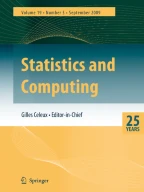Abstract
To facilitate the application of projection depth, an exact algorithm is proposed from the view of cutting a convex polytope with hyperplanes. Based on this algorithm, one can obtain a finite number of optimal direction vectors, which are x-free and therefore enable us (Liu et al., Preprint, 2011) to compute the projection depth and most of its associated estimators of dimension p≥2, including Stahel-Donoho location and scatter estimators, projection trimmed mean, projection depth contours and median, etc. Both real and simulated examples are also provided to illustrate the performance of the proposed algorithm.





Similar content being viewed by others
Explore related subjects
Discover the latest articles, news and stories from top researchers in related subjects.References
Barber, C.B., Dobkin, D.P., Huhdanpaa, H.: The quickhull algorithm for convex hulls. ACM Trans. Math. Softw. 22, 469–483 (1996)
Bremner, D., Fukuda, K., Marzetta, A.: Primal-dual methods for vertex and facet enumeration. Discrete Comput. Geom. 20, 333–357 (1998)
Donoho, D.L., Gasko, M.: Breakdown properties of location estimates based on halfspace depth and projected outlyingness. Ann. Stat. 20, 1808–1827 (1992)
Floyd, R.W., Rivest, R.L.: Algorithm 489: Select. Commun. ACM 18, 173 (1975)
Halin, M., Paindaveine, D., Šiman, M.: Multivariate quantiles and multiple-output regression quantiles: From L1 optimization to halfspace depth. Ann. Stat. 38, 635–669 (2010)
Hawkins, D.M., Bradu, D., Kass, G.V.: Location of several outliers in multiple regression data using elemental sets. Technometrics 26, 197–208 (1984)
Hubert, M., Van der Veeken, S.: Robust classification for skewed data. Adv. Data Anal. Classif. 4, 239–254 (2010)
Liu, R.Y.: On a notion of data depth based on random simplices. Ann. Stat. 18, 191–219 (1990)
Liu, R.Y.: Data depth and multivariate rank tests. In: Dodge, Y. (ed.) L1-Statistical Analysis and Related Methods, pp. 279–294. North-Holland, Amsterdam (1992)
Liu, X.H., Zuo, Y.J., Wang, Z.Z.: Exactly computing bivariate projection depth median and contours. Preprint (2011)
Mosler, K., Lange, T., Bazovkin, P.: Computing zonoid trimmed regions of dimension d>2. Comput. Stat. Data Anal. 53, 2500–2510 (2009)
Paindaveine, D., Šiman, M.: On directional multiple-output quantile regression. J. Multivar. Anal. 102, 193–392 (2011)
Paindaveine, D., Šiman, M.: Computing multiple-output regression quantile regions. Comput. Stat. Data Anal. 56, 840–853 (2012a)
Paindaveine, D., Šiman, M.: Computing multiple-output regression quantile regions from projection quantiles. Comput. Stat. 27, 29–49 (2012b)
Rousseeuw, P.J., Hubert, M.: Regression depth (with discussion). J. Am. Stat. Assoc. 94, 388–433 (1999)
Rousseeuw, P.J., Leroy, A.: Robust Regression and Outlier Detection, p. 99. Wiley, New York (1987)
Ruts, I., Rousseeuw, P.J.: Computing depth contours of bivariate point clouds. Comput. Stat. Data Anal. 23, 153–168 (1996)
Serfling, R.: Depth functions in nonparametric multivariate inference. In: Liu, R.Y., Serfling, R., Souvaine, D.L. (eds.) Data Depth: Robust Multivariate Analysis, Computational Geometry and Applications. DIMACS Series in Discrete Mathematics and Theoretical Computer Science, vol. 72, pp. 1–16. American Mathematical Society, Providence (2006)
Stahel, W.A.: Breakdown of covariance estimators. Research Report 31, Fachgruppe für Statistik, ETH, Zürich (1981)
Swarup, K.: Linear fractional functionals programming. Oper. Res. 13, 1029–1036 (1965)
Tukey, J.W.: Mathematics and the picturing of data. In: Proceedings of the International Congress of Mathematicians, pp. 523–531. Cana. Math. Congress, Montreal (1975)
Zuo, Y.J.: Projection based depth functions and associated medians. Ann. Stat. 31, 1460–1490 (2003)
Zuo, Y.J.: Multidimensional trimming based on projection depth. Ann. Stat. 34, 2211–2251 (2006)
Zuo, Y.J., Cui, H.J.: Depth weighted scatter estimators. Ann. Stat. 33, 381–413 (2005)
Zuo, Y.J., Lai, S.Y.: Exact computation of bivariate projection depth and the Stahel-Donoho estimator. Comput. Stat. Data Anal. 55, 1173–1179 (2011)
Zuo, Y.J., Serfling, R.: General notions of statistical depth function. Ann. Stat. 28, 461–482 (2000)
Zuo, Y.J., Cui, H.J., He, X.M.: On the Stahel-Donoho estimators and depth-weighted means for multivariate data. Ann. Stat. 32, 189–218 (2004)
Acknowledgements
This work was done during Xiaohui Liu’s visit to the Department of Statistics and Probability at Michigan State University as a joint PhD student. He thanks his co-advisor Professor Yijun Zuo for stimulating discussions and insightful comments and suggestions and the department for providing excellent studying and working condition. The authors would like to thank two anonymous referees, an associate editor and the editor for their careful reading of the first version of this paper. Their constructive comments led to substantial improvements to the manuscript.
Author information
Authors and Affiliations
Corresponding author
Rights and permissions
About this article
Cite this article
Liu, X., Zuo, Y. Computing projection depth and its associated estimators. Stat Comput 24, 51–63 (2014). https://doi.org/10.1007/s11222-012-9352-6
Received:
Accepted:
Published:
Issue Date:
DOI: https://doi.org/10.1007/s11222-012-9352-6



